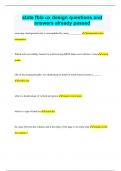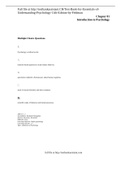The origins and development of comedy
- Comedy emerged out of the worship of Dionysus – like tragedy
- Key element in the festival was the komos (revel) – an example of how Dionysus was a god who could
relieve people of their daily troubles through wine
Another key element of the komos was the icon of the human phallus – Dionysus was commonly
associated with the life force
Phallus as a symbol of his power and ability to bring new life
- Generally agreed that comedy emerged from the songs and dances of the komos
- The Greek word from which comedy is derived from literally meant ‘the song of komos’
- First recorded entry for a comedy in the city Dionysia was in 486 – we know little about comedy in the
early decade of the 5th century
Detailed knowledge of 5th century comedy is related to Aristophanes (an Athenian comic
playwright, 450-386)
We have references to other comic playwrights and fragments from their plays
Only the playwrights of Aristophanes were preserved into late antiquity – for unknown reasons
wince other playwrights were treated with equal importance
- Aristophanes was writing at the same time as Sophocles and Euripides
- The major of Aristophanes plays were written during the Peloponnesian war
His plays are often intensely satirical, making fun of public life and public figures
Although he was writing to entertain his work offers an insight into the political issues of the day
- During the 4th century comedy changed a great deal in nature – the importance of the chorus was
significantly reduced
- 320’s – new form of comedy had emerged
Far less political
Conventionally referred to as ‘new comedy’
Actors and the chorus
- Likely that comedy allowed a fourth actor on stage
- Comic chorus constituted of 24 members
In some plays a chorus was divided into two semi-choruses – each supported a different side of
the argument in the play
- Comic actors sometimes broke the dramatic illusion by acknowledging the presence of spectators and
at times even addressing them directly
Especially during the parabasis
Costumes and masks
- Most noticeable difference between comedy and tragedy was their respective costumes and masks
Those of comedy were designed to make the actors look ridiculous and build up the element of
farce
- Comic actor wore a short tunic, a cloak reaching just below the waist and tights
Whole costume was padded – especially around the midriff and backside
o Made an actor look shorter and rounder than he actually was
o Also enabled them to fall and roll around – comedy often involved physical humour and
slapstick
- Key element was the oversized leather phallus
- Facial features on masks were grossly exaggerated and mouths often ridiculously large
- Some plays satirised public figures – masks of these characters must have parodied their real looks
Humour and comic techniques
- Plots of comedy were far loosed than the ones of tragedy












